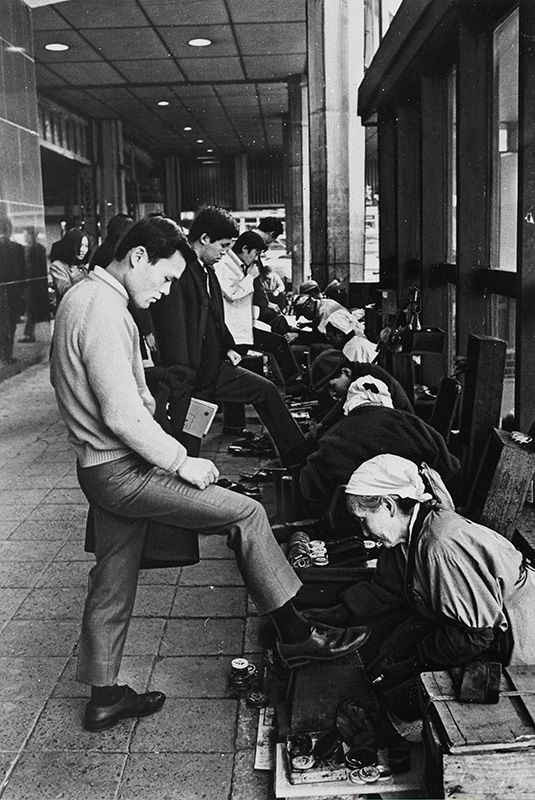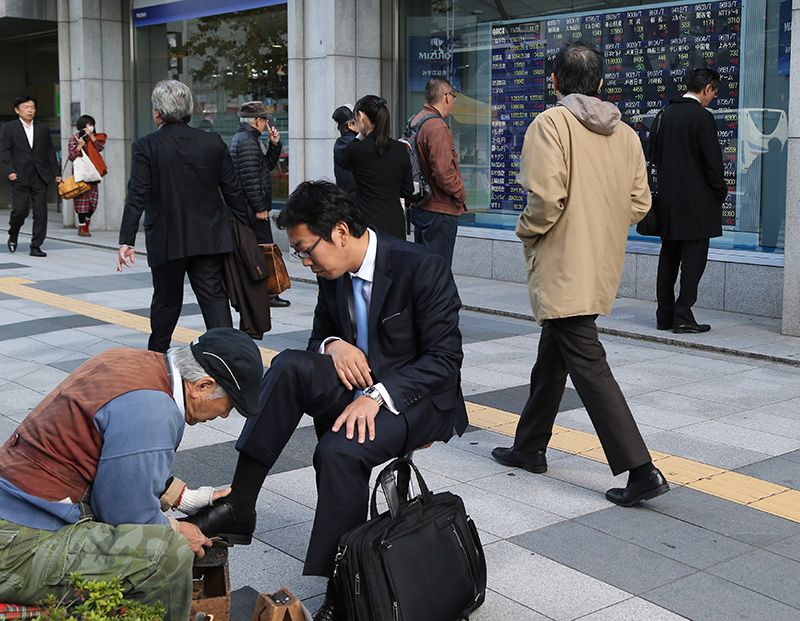
The Glow of the Human Touch: Why Shoeshine Stands are Making a Comeback
Society Lifestyle- English
- 日本語
- 简体字
- 繁體字
- Français
- Español
- العربية
- Русский
The words “street children” don’t conjure up images of Japan for most people, but don’t be fooled into thinking that no link exists. The 1950s, for example, saw big hits for both Akatsuki Teruko with her 1951 song “Tōkyō shūshain bōi” (Tokyo Shoeshine Boy) and Miyagi Mariko with “Gādoshita no kutsumigaki” (The Shoe Polisher Beneath the Tracks) in 1955.
Urban Poor in Times of Prosperity
 A long row of shoeshine stands on a Shibuya street in 1969. (Mainichi Newspaper/AFLO)
A long row of shoeshine stands on a Shibuya street in 1969. (Mainichi Newspaper/AFLO)
1955 marked exactly a decade since the end of the Pacific War. Large-scale reconstruction work was in full swing all over Japan; this was the year in which the nation’s peacetime economy finally managed to haul itself back into the black. A popular saying spoke of how the postwar period was over at last, and most middle-class households were able to amass the “three sacred treasures”: refrigerator, washing machine, and black-and-white television.
There were many across the country still struggling in poverty, though, and it was also in this period that disadvantaged youths who had made shoe-shining their profession became a common fixture on urban street corners. These youngsters—some of whom were working to lend financial support to their parents and siblings—set up at station fronts and under bridges to earn their crust polishing the footwear of commuters and evening revelers. The postwar wave of reconstruction and economic recovery had reached most corners of the nation, but an air of hardship remained.
The upshot of this, though, was a wealth of daily interactions that evinced a very human warmth—not just in the provinces, but in the larger cities as well. For many, lively exchanges with shoeshine boys or the elderly peddlers offering their wares on roadside stalls were an integral part of everyday life.
The Cost of Progress
As the months and years rolled on, life got progressively easier for the people of Japan—thanks in large part to the increased pace of mechanization. And as economic and social development became clearer throughout the nation, the visible signs of poverty gradually began to fade away.
When I came to Osaka as a student in 1978, the town was still abuzz with very human interactions. In those pre-JR days when the state-owned rail provider, Japanese National Railways, was still known affectionately as Kokutetsu, there were many stations at which automatic ticket barriers had yet to be installed. It was still necessary to have your ticket punched by the station attendant. Even though the exchange lasted only a few seconds, such small acts of communication between passenger and staff were repeated several times each day.
As another example, when I first moved in near Higashi Hanazono on the Kintetsu line, Japanese friends would sometimes take me to the many local sunakku, or “snack” bars, where we could enjoy singing karaoke together. Amid the lively conversation and duets with the staff and fellow customers—even when meeting for only the first time—there was, again, a regular avenue for human engagement.
Interestingly, 1978 was also the year in which the popularity of Space Invaders heralded the dawn of the video game era. And from this point onward, the encroachment of machines into all aspects of life gathered pace. Automatic gates began to appear at stations. Singing together at snack bars gradually fell by the wayside in favor of private, computerized karaoke boxes.
And in much the same way, the shoeshine boys also disappeared. Fast, convenient shoe-repair stands like Mister Minit became a common feature of supermarkets and department stores. Furthermore, new products like quick-drying waxes made it swift and easy for people to polish their own footwear right before leaving the house.
The Human Touch
 Shoeshine stands are starting to make a comeback, even in Tokyo’s upmarket Ginza district. (AP/AFLO)
Shoeshine stands are starting to make a comeback, even in Tokyo’s upmarket Ginza district. (AP/AFLO)
The world grew more and more comfortable, and chances for one-to-one interaction became fewer and further between. All the while the number of Japanese suffering from social isolation steadily increased. But all of a sudden, as if in an attempt to fight their collective sense of loneliness, people here have begun to seek each other out once more.
And so it is that recently, particularly in Tokyo, street-corner shoeshine stands are starting to make a comeback, often near stations. Some feel, it would seem, that at the end of a hard day, exchanging in small talk with the oyaji (older gentleman) who is shining your shoes is a great way to relieve stress. So, when in search of some much-needed human warmth, what better way to relax on your way home from work than to pause for a while and get your shoes shined?
(Originally written in Japanese and Arabic.)
recovery postwar economy tradition Society technology isolation